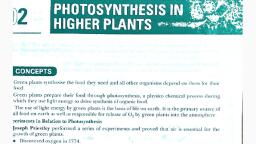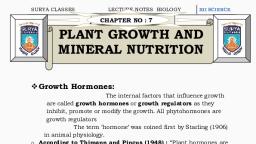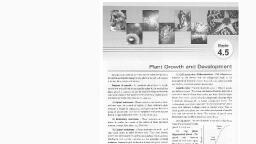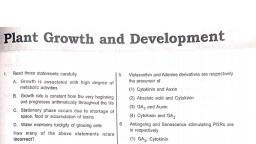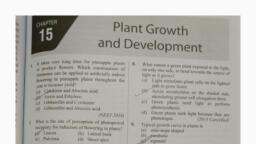Page 1 :
j, j, , , , in, , 62, , , , , , , , , Aas, Ta ay, , , , Growth and Development |, © Development Ws the sum of avo Processes: growth and differentiation,, * Growth is re, , garded as one of the Most fundamental and, Sonspicuous characteristic of a living: being., , , , , , , , , , , , *® Growth can be defined as an inveversible permanent increase, MW size of an organ or its Parts or even of an individual cell,, ® Growth is accompanied by metabolic Processes (both anabolic, and catabolic), that occur at the expense ofenergy. Therefore, Shoot Vascular, for example, expansion of a leat is growth. Carnbium, @ Plant growth is unique beeause they have unlimited growth, throughout their life. ‘This ability of the plants is due to the, presence of meristems at certain locations in their body., @ The cells of such meristems Nave the capacity to divide and, selfsperpetuate, “The product, however, soon looses the Vascular, capacity to divide and such cells make up the plant body. sani, ® This torm of growth wherein new cells aire always being added, to the plant body by the activity of the meristem is called the, open form of growth,, & . Seri 7 —— Root apical, ® Primary growth of the plants Principally conuribute to the meristem, elongation of the plants along their axis. Fig. 4:1 Diagrammetc, e@ In dicotyledonous plants and ¥ymnosperms, the lateral representation of locations of, ° meristems, vascular cambium and cork-cambium appear later root apical meristem, shoot apica |, fii life: moristom and vascular camblum i, e, , These are the meristems that cause the ine, acuye, This is known as second, Growth can be Measured, , e ¢, , , , se in the girth of the or, ary growth of the plant., , , , : j, ans in which they ar, , , , srowth, ata cellular level, is principally a consequence of increase i, , , , , , mount of protoplast!), , Growth is, therefore, measured by a variety of p some of which are, , ameters, weight, dry weight, length, area, volume and cell number,, @ One single m, , , , increase in fies),, , ¢ to more than 17,500 new cells per hour, in cell number., , Cells in a watermelon may increase in size by up-to, Increase in size of the cell., , , , Ize root apical meristem can give r, here, growth is expressed as increase, , , , 3,50,000 times, here growth is expressed !, , , , While the growth of a pollen tube is measured in terms of its length, an increase in surface av, denotes the growth in a dorsiventral leaf,, , Plant growth regulators, , sof diverse chemical c cositi¢, @ The plant growth regulators (PGRs) are small, simple molecules of diverse chemical compo, @ They .could be indole compounds (indole-2, , , , ‘ arjyaltis, acetic acid, IAA); adenine derivatl, , Biology-X}: Term-2
Page 2 :
ST, , ng qefurfarvlarmine purine, kinetin), derivatives of carotenoids (abscisic acid, ABA); terpenes, ( cid, Gay) or gases (ethylene, CoH). Plant growth regulators are variously described, , a, phere, f ie int growth substances, plant hormones or phytohormones,, as ple bits, rhe pors can be broadly divided into two groups based on their functions in a living plant, 1, paddy, ONE, , entargemen, ce also called plant growth promoters, eg., auxins, gibberellins and cytokinins,, , group of PGRs are involved in growth promoting activities, such as cell division, cell, t, pattern formation, trople growth, flowering, fruiting and seed formation., , These at, group 1s involved in various growth inhibiting activities such as dormancy and, , fhe other a ., The PGR abscisic acid belongs to this group., , abscission, The gaseous PGR, ethylene, could fit either of the groups, but it is largely an inhibitor of, growtlt activities., jant growth regulators- The discovery, at ; : P, piseovery of all the five PGRs are accidental., ¥ Charles Darwin and his son Francis Darwin observed that the coleoptiles of canary grass, responded to unilateral Mlumination by growing towards the light source (phototropism). After, , series of experiments, it was concluded that the tip of coleoptile was the site of transmittable, influence that caused the bending of the entire coleoptile., Auxin was isolated by F.W. Went from tips of coleoptiles of oat seedlings., E. Kurosawa reported the appearance of symptoms of the disease in uninfected rice seedlings, when they were treated with sterile filtrates of the fungus. The active substances were later, identified as gibberellic acid., F Skoog and his co-workers observed that from the internodal segments of tobacco stems the, aallus proliferated only if in addition to auxins the nutrients medium was supplemented with, one of the following: extracts of vascular tissues, yeast extract, coconut milk or DNA., Skoog and Miller, later identified and crystallised the cytokinesis promoting active substance, that they termed kinetin. During mid-1960s, inhibitor-B, abscisin Il and dormin were reported., , a?, , , , Later all the three were proved =, to be chemically identical. It was, named abscisic acid (ABA)., , e Cousins confirmed the release, , of a volatile substance from, , ripened oranges that hastened, the ripening of stored unripened, bananas. Later this volatile, , substance was identified as, b c d, , ethylene, A Base OUS PGR. Fig. 4.2: Experiment demonstrating that the tip of coleoptile is the, , source of auxin, , , , 5, Physiological Effects of Plant Growth Regulators, , , , , , S.No. Name of the Regulator Function, 1 Auxin (Indole 3-Acetic Acid -IAA) (@) Responsible for apical dominance., Synthetic Auxin: (ii) Controls growth of plant cells., , (iii) Initiates rooting in stem cuttings., (iv) Controls cell division., , @ Indole butyric acid, , @ Naphthalene acetic acid, (v) Controls xylem differentiation., , (vi) Prevents premature fall of leaves, flowers, and fruits., (vii) Induces parthenocarpy., , @ 2, 4-dichlorophenoxyacetic acid, , , , peace DAA, , , , , , , , (viii) Promotes flowering in pineapple, litchi, etc., , , , Plant Growth and Development | 63
Page 4 :
. lications of of them., There are five main groups of natural plant growth sielae any one, , ators enised, gural hormones in plants, These are: $ which are very much recogni, , asm, oO Axis, , i) Gibberellins, (iw) Cy tokinins, , () Abscisic acid, , (e) Ethylene, , piscovery of auxin: In 1880, Charles Darwin and, canary grass and found the existence of a substance in coleoptile tip, which was able to recognise, the light stimulus and leads to the bending of tip towards light. I Z, Paal (1919) reported that the substances secreted ii f, , caused cell elongation in half portion which was o, observed in opposite direction., , Francis Darwin worked with the coleoptile of, , the tip are translocated downwards and, n the dark side and hence bending was, , EW. Went (1928) further refined this experiment and supported the observations of Paal. He, was the first person to isolate and name these substances of tip as auxins., , In 1931, Kogl and Haagen-Smit isolated crystalline compounds from human urine. These were, named as auxin-a, auxin-b and heteroauxin., , Physiological functions of auxins:, , (i) Responsible for apical dominance, , (i) Controls growth of plant cells, , (ii) Initiates rooting in stem cuttings, , (wv) Controls cell division, , (v) Controls xylem differentiation, , (vi) Prevents premature fall of leaves, flowers and fruits, , (vii) Induces parthenocarpy, , Agricultural/horticultural application of auxins:, , (@ Application of auxins like IAA, IRA, NAA induces rooting in stem cuttings of many plants., This method is widely used to multiply several economically useful plants., , (t) Normally, auxins inhibit flowering however in litchi and pineapple, application of auxin, promotes flowering thus used in orchards., , (ii) Auxin induces parthenocarpy in some plants including tomato, pepper, cucumber and, Citrus, thus, produces seedless fruits of more economic value., , (@) Auxins like 2, 4-D and 2, 4, 5-T are commercially used as weedicides, due to their low cost, and greater chemical stability. They are selective herbicides (killing broad-leaved plants, but, Not grasses)., , (v) For checking premature fruit drop, auxins are applied which prevent the formation of, abscission zone in the petiole or just below the fruit. Auxin regulates maturing fruit on the, trees of apples, oranges and grape fruit. High doses of auxins can cause fruit drop. Thus,, heavy applications of synthetic auxins are used commercially to promote a coordinated, abscission of various fruits to facilitate harvesting., , Ans, Pid is abscisic acid also known as stress hormone? 7 / a, , “ls as a general plant growth inhibitor and an inhibitor of plant metabolism. ABA inhibits, seed germination. ABA stimulates the closure of stomata in the epidermis and increases the, tolerance of plants to various kinds of stresses. Therefore, it is also called the stress hormone., , , , Plant Growth and Development | 65, , re fe "ee a, , , , , , renter, , ee RES:
Page 5 :
ulators would you use if you are asked to:, (ii) quickly ripen a fruit, (iv) induce growth in axillary buds, , | 4. Which one of the plant growth reg, @) induce rooting in a twig :, , :, , (iH) delay leaf senescence :, (vi) induce immediate stomatal closure in leaves j, , (v) ‘belt’ a rosette plant, , Ans. @) Auxins like IBA, NAA (i) Ethylene, (ef) Cytokinins (iv) Cytokinins, () Gibberellins (vi) Abscisic acid (ABA), , 5. What would be expected to happen ift, (i) GAg is applied to rice seedlings, (ii) dividing cells stop differentiating, (iii) a rotten fruit gets mixed with unripe fruits, (iv) you forget to add cytokinin to the culture medium i, Ans. {i) The rice seedlings will show internode-elongation and hence an increase in the height vi, be observed if GA, is applied to them., (ii) Ifthe dividing cells stop differentiating, the different plant parts such as the stem and leay, will not form., , , , }, , , , (@) Ifa rotten fruit gets mixed with unripe fruits, then the plant growth regulator — ethyl, , , , that is synthesized from the rotten fruits will speed up the process of ripening of the unrj :, fruits., (z) If you forget to add cytokinin to the culture medium, then the process of cell division,, differentiation and growth will be dampened and get slower. A, as, ‘ <_, a b € d, Experiment used to demonstrate that tip of the coleoptile is the source, of plant hormone. Arrows Indicate direction of light, (i) The experiment is related to the discovery of which plant hormone?, (ii) Mention any two important roles of this hormone., (iii) Who discovered this hormone?, (iv) Name any two synthetic hormones similar to the hormone related to the diagram., {v) Does the hormone concerned perform apical dominance?, Ans. 4) The experiment is related to the discovery of auxin (Indole Acetic Acid)., (ii) Auxin performs following important roles:, {a) Root initiation in stem cutting., , (by Auxin prevents Jeaf and fruit drop (abscission) in case of early stage but prom, abscission in case of older leaves and matured fruits., , , , 66 { Biology-XI: Term-2







